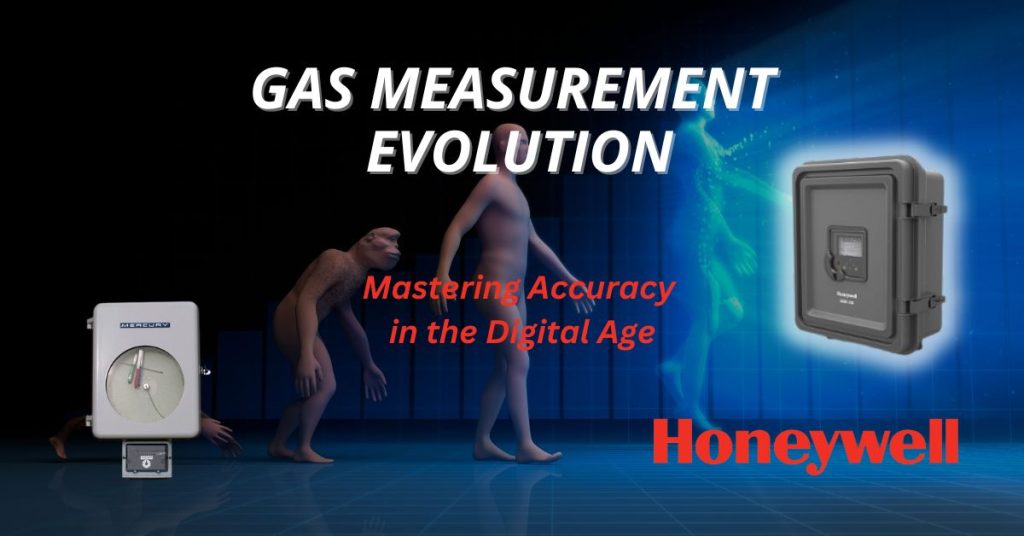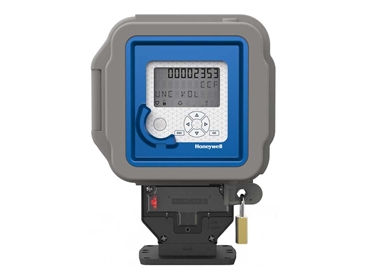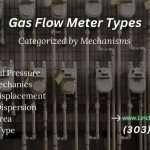Gas Measurement: Mastering Accuracy in the Digital Age
Accurate natural gas measurement is crucial in today’s energy landscape. Volume correction, the process of converting a gas meter’s uncorrected volume to a corrected volume based on temperature and pressure effects, is vital in enhancing measurement precision. This correction significantly improves the accuracy of natural gas measurement, which is essential for custody transfer and billing in our increasingly data-driven industry.
Natural Gas Measurement
Previous discussions have explored the evolution of natural gas meters and their improving accuracy. As industry needs evolved, meters were developed for various applications. However, our deepening understanding of gas laws—particularly how pressure and temperature influence flow measurement—has driven innovation towards more sophisticated volume correction methods for pressure and temperature.
Custody transfer refers to a metering point where natural gas is measured for sale and ownership transfers between parties. In fiscal metering, accuracy is not just a preference but a strict requirement governed by industry standards, government regulations, custody contracts, and metrology standards. In 2024, these requirements are more stringent than ever, reflecting the high stakes in energy transactions.
Mechanical Correction
The gas industry’s journey toward accuracy began with mechanical devices. In the 1950s, innovations like chart recorders and mechanical and volume correctors laid the groundwork for modern measurement techniques. While these technologies are now largely obsolete, understanding their principles helps appreciate current digital solutions.
The gas industry set out to design devices that would adjust for the effects of pressure and temperature. In the 1950s, some of those mechanical devices were chart recorders and mechanical correctors or volume correctors.
Electronic Correction
The 1980s saw a paradigm shift with the introduction of electronic volume correctors (EVCs) by companies like Mercury Instruments (now Honeywell Mercury). These devices, essentially ruggedized computers, compensated for real-time temperature, pressure, and gas compressibility. By 2024, EVCs have become more sophisticated, with improved accuracy and additional features. Some may incorporate advanced data analytics for predictive maintenance, though specific implementations vary by manufacturer.
Audit Trail, Telemetry, and Wireless
The 1990s brought significant advancements: audit trails for data integrity, modems for remote data transmission, and the dawn of wireless communication. Fast-forward to 2024, and we see a fully integrated ecosystem of smart meters, audit trails, and real-time data transmission, revolutionizing the industry’s approach to measurement and data management.
Today’s Electronic Correctors and Electronic Converters
Today, electronic correctors are the cornerstone of advanced gas measurement systems. They seamlessly integrate with Internet of Things (IoT) platforms, perhaps even leveraging artificial intelligence for predictive analytics. Modern correctors not only perform volume correction but also provide real-time insights into energy consumption patterns, enabling utilities to optimize their operations and offer personalized services to customers.
Cutting-edge Solutions from Honeywell Mercury
As we look to the future, the gas measurement industry continues to evolve. Emerging technologies like quantum sensors and edge computing promise even greater accuracy and efficiency. For those interested in staying at the forefront of this technology, Honeywell Mercury offers cutting-edge solutions like the EC350 Volume Converter and MiWi350 Volume Corrector.
Contact us to learn how these advanced systems can transform your gas measurement operations.





Very useful
My gas supplier uses a correction factor multiplier of 1.3 to compensate for 2psi gas from their pressure regulator going through their meter which is calibrated for 5 psi. Isn’t the volume of 2 psi less than the volume of 5psi? Am I getting less gas than I am paying for?
Tony,
A member of our team will be contacting you by email. Thanks for your question.
I have an old roots meter on my property measuring the gas coming off of a well. The meter has (READING X 100:CU.F) underneath numbers. If the numbers on the meter are 51015 and the pressure is 28psi what is the corrected reading in mcf?
Ken, 28psig corrects to 2.8912 (using 60degF fixed/ 14.73psia base & 14.40psia atmospheric pressure). Uncorrected reading=51015 X 2.8912(Correction Factor) =147494.56. Answer= 147494.56 (X100) Corrected volume.
Ken, since no line gas temperature was provided I had use a fix factor to do the calculations. I have a correction factor of 2.878 using a fixed Gas Temperature of 60 degrees which would make the corrected volume 146821.17. If you have any questions please call us at 303-697-6701.
great article. so i work for a small gas municipality. i am trying to encourage my employer to install these ecat instruments to get a more precise read which could mean more revenue. do you know what is a common standard when ecats are to be installed. is it based on usage?
great article. so i work for a small gas municipality. i am trying to encourage my employer to install these ecat instruments to get a more precise read which could mean more revenue. do you know what is a common standard when ecats are to be installed. is it based on usage?
great article. so i work for a small gas municipality. i am trying to encourage my employer to install these ecat instruments to get a more precise read which could mean more revenue. do you know what is a common standard when ecats are to be installed. is it based on usage?
Hello Susan, so i have a few questions for you. (First of all sorry for my bad english). I’ve been working with Mini-Max since 8 months and i’ve been asking myself this:
How is tested the main board of this instruments?
Is there a special test for every communication port?
How is tested the AMR in the instrument?
Is there a different specification for every customer?
Do you have any idea of how the volume correction is tested?
Mr. Contreras,
Thank you for your inquiry and interest in the Honeywell Mercury Instruments Mini-Max. To direct you to the correct person to answer your questions, may I ask the name of your company and your location?
Regards
Hi, just want to know relationship between actual gas thru regulator between calculation by evc. I just wondering when, the pressure was fluctuate and less than supply pressure the correction factor become less and affect the customer billing. In that case we underbill the customer. Is it true?
Sir:
I am not sure that I understand your question:
Normally when measuring gas at an elevated pressure, you need to make sure that the supply pressure to the control system (gas regulator) is always going to be higher than the pressure going thru the metering device (gas meter).
If the gas supply pressure would drop below the gas regulator outlet pressure to the gas meter then the actual pressure correction factor will change going in a negative direction and in effect lowering the customer energy value received, but would probably not show up in the billing statement.
The only way to be sure this is not taking place to install a pressure recorder to measure the metering pressure.
While the actual practice the changing of gas pressure to the gas regulator is always a concern to the design engineer and they must always take into account the know pressure losses from the source and select the correct gas regulator for the known application.
Thank you Mr. Thomas but infact we have installed electronic volume correctors which showing negative pressure due to low inlet pressure resulting dropped in corrected volume logged in EVC. What should I do?
Have you check the connections of the pressure transmitter for correct polarity? If correct then you have may have the wrong range on the pressure transmitter.
Tom
Excellent piece
I m facing big prob please helpout memy supplier comp charged me volume of gas around 2925 hm3. Reasing its fault vol which dit charge u in last 7 months so its evc data how i can fight this plz even zero pressure
Thx
Riaz, a member of Linc Energy Systems will be in contact with you by email. Thank you for your inquiry.
Sir i start doing job in igl delhi,as i am new could you tell me in easy way corrected volume,correction factor,uncorrected volume,evc use,how to find out consumption in scmh.pls elaborate pr in bar.
Hi, I am working in a gas distribution company. Recently we have come across a situation where a Factory having Meter installed with EVC. On the outlet the customer has installed a powerful suction pump which is actually feeding in a large bottle to create higher pressure reservoir to power its 1.3mega gas generator. The EVC data reveals negative pressure factor through the time when suction pump is ON. My question is whether the customer is being under billed due to these persistent negavetive pressure as EVC converts the uncorrected volumes to corrected volumes which is actually billed to the customer.. Your response will be highly appreciated
Kesperoy, I have passed your inquiry on to a member of Linc Energy Systems, and someone will be in touch. In the interim, you can reach us at info[at]lincenergysystems.com.
Does anyone know the basic formula for converting uncorrected flow rate to scf/hr?
what formula is used to convert the natural gas uncorrected Volume from a meter to corrected or vise versa? eg having 1200 standard cubic meters as uncorrected how do I convert it to corrected at a given pressure of 101.325kpa and temperature of 15 degrees
Hi, I am working in a gas distribution company. Recently we have come across a situation where a Factory having Meter installed with EVC. On the outlet the customer has installed a powerful suction pump which is actually feeding in a large bottle to create higher pressure reservoir to power its 1.3mega gas generator. The EVC data reveals negative pressure factor through the time when suction pump is ON. My question is whether the customer is being under billed due to these persistent negavetive pressure as EVC converts the uncorrected volumes to corrected volumes which is actually billed to the customer.. Your response will be highly appreciated
Hi, I am working in a gas distribution company. Recently we have come across a situation where a Factory having Meter installed with EVC. On the outlet the customer has installed a powerful suction pump which is actually feeding in a large bottle to create higher pressure reservoir to power its 1.3mega gas generator. The EVC data reveals negative pressure factor through the time when suction pump is ON. My question is whether the customer is being under billed due to these persistent negavetive pressure as EVC converts the uncorrected volumes to corrected volumes which is actually billed to the customer.. Your response will be highly appreciated
Hi, I am working in a gas distribution company. Recently we have come across a situation where a Factory having Meter installed with EVC. On the outlet the customer has installed a powerful suction pump which is actually feeding in a large bottle to create higher pressure reservoir to power its 1.3mega gas generator. The EVC data reveals negative pressure factor through the time when suction pump is ON. My question is whether the customer is being under billed due to these persistent negavetive pressure as EVC converts the uncorrected volumes to corrected volumes which is actually billed to the customer.. Your response will be highly appreciated
Your team would be appreciated if they can help me out to understand the process for of correction factor calculation.
Hello, I am hoping someone can steer me in the right direction. I live North of Houston Texas, and am having a $1k problem with my utility. My gas usage in CCF (not dollars) suddenly increased last year for my residence with three people living there with no business in the home or changes. There are no leaks or issues with the appliances in the home. When I have the utility come to the house, the reading is normal, when they don’t visit the house, it’s huge.
If you take my data for the last 18 months, it looks like they owe me $1,000 and are saying that I used 300+ CCF in one month doing laundry and taking showers with three people. CAN YOU PLEASE help me? My utility is giving me the runaround.
Reading Date Meter CCF
Aug 25,2023 2277 25
Jul 26,2023 5296 32
Jun 26,2023 5267 128
May 25,2023 5152 332
Apr 28,2023 4855 285
Mar 28,2023 4600 89
Feb 27,2023 4520 253
Jan 30,2023 4294 238
Dec 29,2022 4081 211
Nov 29,2022 3892 206
Oct 24,2022 3708 19
Sep 26,2022 3691 20
Aug 25,2022 3673 15
Jul 26,2022 3660 10
Jun 27,2022 3651 30